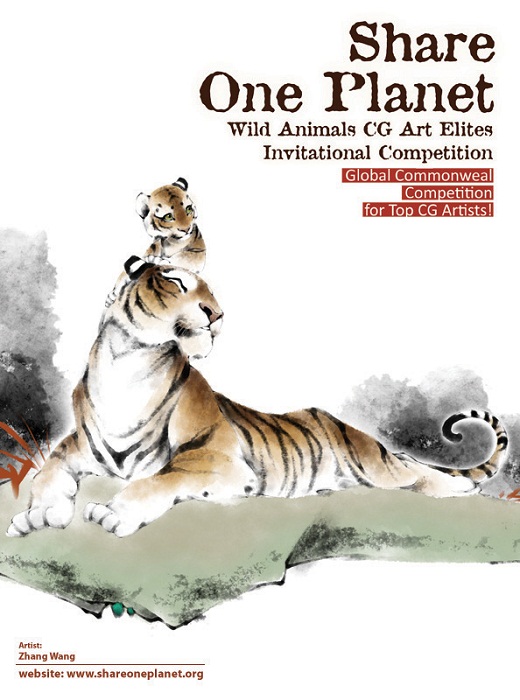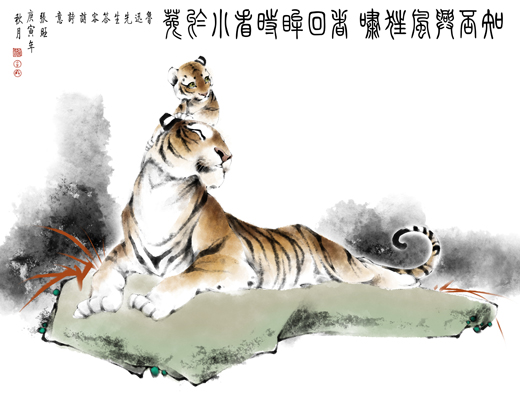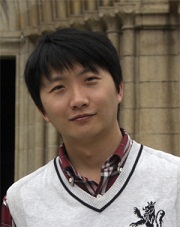Zhang Wang, a famous artist in CG industry, pays great attention and support to Share One Planet competition. Invited by the Organizing Committee, he painted the poster artwork of Mother's Love Category for SOP.

Zhang Wang’s artworks inherit the tendency of traditional Chinese paintings,not only using traditional Chinese cultural references and the essential fundamentals of Chinese painting, but also conveying the impact of new digital media. The distinct contrast grants his art a special quality. In this piece “Roaring Against the Wind”, Zhang was inspired by Lu Xun’s poem ”A stone-hearted hero is no exception a man who cherishes his child. Don’t you know a roaring tiger always turns around to check on his cub?”Zhang steps away from the typical majestic-looking tiger commonly artworks portray,depicted a parent tiger playing with its cub. He wants the tenderness of parenthood reminds us the other side of tigers.
The tiger always appears as a relentless beast since ancient times. Whilst they are dominants in nature, people tend to neglect the disturbing fact they share with other species: endangerment. During the past century, wild tigers suffered from human huntings while their habitats being invaded by human, result in their population decline from 100,000to 3,200 at present, leaving only 6 subspecies out of 9.Protecting wild tigers maintains ecological balance, which is also protecting ourselves. At the end of Chinese Tiger Year, we hope Zhang’s artwork will remind more people to care wild tigers’ living status, and try to conserve habitats for them.

Poster artwork of Mother's Love Category of Share One Planet competition, by Zhang Wang
Next is the interview with Zhang Wang, from SOP Organizing Committee:
1. Initially you were engaged in traditional Chinese painting, which is quite different from modernized stuffs such as PC.So how did CG start to get your attention and finally get you into this particular creation form?
As a matter of fact most of our generation became interested in PC and software before formally learn anything about traditional Chinese painting. Video game consoles, which come into mainland China (especially arcade games) in 80s, have made themselves the boys’ first choice in free time. Honestly, my interest in game CG and relevant software was far greater than that in Chinese painting. Even after I majored in Chinese painting in college, game is still my primal interest.
And the keen interest in various kinds of CG images in games made me gradually develop a distinctive style whilst studying Chinese painting systematically. When I replicate a classical painting, I will observe the artwork as if it’s a CG piece. More specifically, I divide the whole image, for example a planar human portrait, into individual elements, and try to figure out how these elements present in 3 dimensional spaces: whether the composition is reasonable or how the features should be when I mimic it. I will even analyze how the character’s movement will be, or how the rest of body changes when the torso shape deforms. This approach makes replicating no longer a dull job, not only my sketching and coloring skills get trained, but also the classical paintings are branded in my mind.
To be frank with you, when I was majoring in Chinese painting in college, one of my very specific goals is using CG to create artworks, except that I didn’t have a graphics tablet then, so I could only use mouse and keyboard to paint some simple stuff. Still I enjoyed it very much. During my sophomore year, Computer Science was listed in obligatory courses; half-term passed, I already started to code simple animation programs, so I enthusiastically created pieces of Azure Dragon, White Tiger, Vermillion Bird and Black Tortoise( four saint beasts in ancient Chinese mythology) one by one.
The major “turning” occurred when I worked at KOEI Tianjin. My early expectations about CG came to true via the graphics tablet. My ”10 Immortals”, which is a series widely posted on the internet, represent me in this particular period.
2. People can tell you have a solid background of sketching and structuring from your paintings. Would you please tell us why you stick to Gongbi("court-style") techniques when painting (shaping lines, recreate texture with flat colors)?
I would regard it as my respect for the painting art. After I studied Chinese painting, I’ve gain some insight and comprehension of the nature of its Freehand style and Court-style. Especially the Freehand masters’ works, always enchant me and the more time I take to appreciate them, the more I feel that these Freehand style artworks could not be born without strong interest and emotion of its painter. The artists have to express their feelings with skillful strokes, they paint out artworks, create distinctive characters based on their unique life experiences. But I am always aware of my optimism and pursuit of enjoyment that I would never smolder or go through lifetime struggling at that level . In addition, there are so many people pursue vanity with their so called Freehand style or scholar paintings. Those are just cheating. In order,to show my respect for traditional painting, I would think twice before I practice.
As for Court-style painting, it obviously enhance a beginner’s skills of shaping and utilizing tools. At the mean time, I like fine Court-style painting because it shows the sincerity of the painter through their paintings and conveying an idea becomes relevantly simple.
Besides, at my early stage with PC and the graphics tablet, I found the application too limited to mimic the Freehand style in Chinese painting. Therefore I made a huge effort in practicing Court-style painting for a long time. With the increase of my life experiences and my age, my creation focus recently turns to a mixture of Court-style and Freehand style. This change absolutely should thank to the enormous development achieved in software and hardware.
3. Tiger is fierce, but you portray their tenderness in this poster. Would you tell us about the origion of creating this work?
I was inspired by the poem called “Da Ke Qiao (means response to the guest’s sarcasm)”,by Chinese writer Mr. Lu Xun. It says” A stone-hearted hero is no exception a man who cherishes his child. Don’t you know a roaring tiger always turns around to check on his cub?”
Mr. Lu Xun is a writer I admire so much. His poem describes the bravery of a man and his affection to his children, which for me is quite touching. It makes me add hints of humanity on the fierce tiger when I develop the concept. The purpose is to show how adorable, precious and beautiful this wild animal is, to encourage the public to care for and protect wild animals. It shows my constant support to the wildlife protection as a Chinese digital artist, as well as my wholehearted support to this commonweal activity sponsored by the Foundation.
4. Many of the characters you’ve portayed are imaginary character ancient Chinese people invent out of the nature, and nowadays people know they don’t exist in reality. Would you tell us your opinion about those mythological animals? In your mind how the ancient people treat the nature and how modern people would do differently?
Certainly it often comes to my mind that the animals we have never seen yet or would have never imagined, they may actually exist. The scientific definition of “nonexistence” is described as “have not been yet witnessed within a limited region”.
On airplane I occasionally come across with the sea of clouds, and then I cannot help wondering whether there are Vermillion Birds flying in the cloud at that moment.
When I am face to face with the open sea, with the turbulent waves in front of me, I am also very excited about the idea that there might be Azure Dragon swimming under the water.
The ancient Chinese people believe in the “harmony of man and the nature” and there’s the saying in Taoism that “Taoism follows nature”. It shows their reverence towards the nature. There are also verses like “While picking asters underneath the Eastern fence.My gaze upon the Southern mountain rests” and “We appreciate each other,
The Jingting Mountain and I”, showing an attitude of treating the nature as a friend, which is something we lack in modern times. I consider it to be a kind of vice in our modern society.
5. Do you usually pay attention to the wild animals and the environment? What’s your expectation of the relationship between human and the nature?
My family and I all love animals, we do care about the wild animals and the enviroment. Everyone would be excited about the prosperity of a certain species and would feel sorry for the their extinction. We would be out of rage if human’s greed causes more tragedies for the nature.
My expectation for the relationship between human and the nature is quite simple: human take one step back and we all live in harmony.
About Zhang Wang
|

|
|
Zhang Wang
Chinese CG artist, graduated from the Oriental Culture and Art Department of Nankai University. He used to be professor at Animation Department of Tianjin University, then turned to teach at Nankai University. His works were featured in “EXPOSÉ 2” and won many awards both in China and international exhibits. He also provided character design for various projects of “Novoland”, as well as game titles such as “Shushan Online”, “Wan Mei” etc.
|

